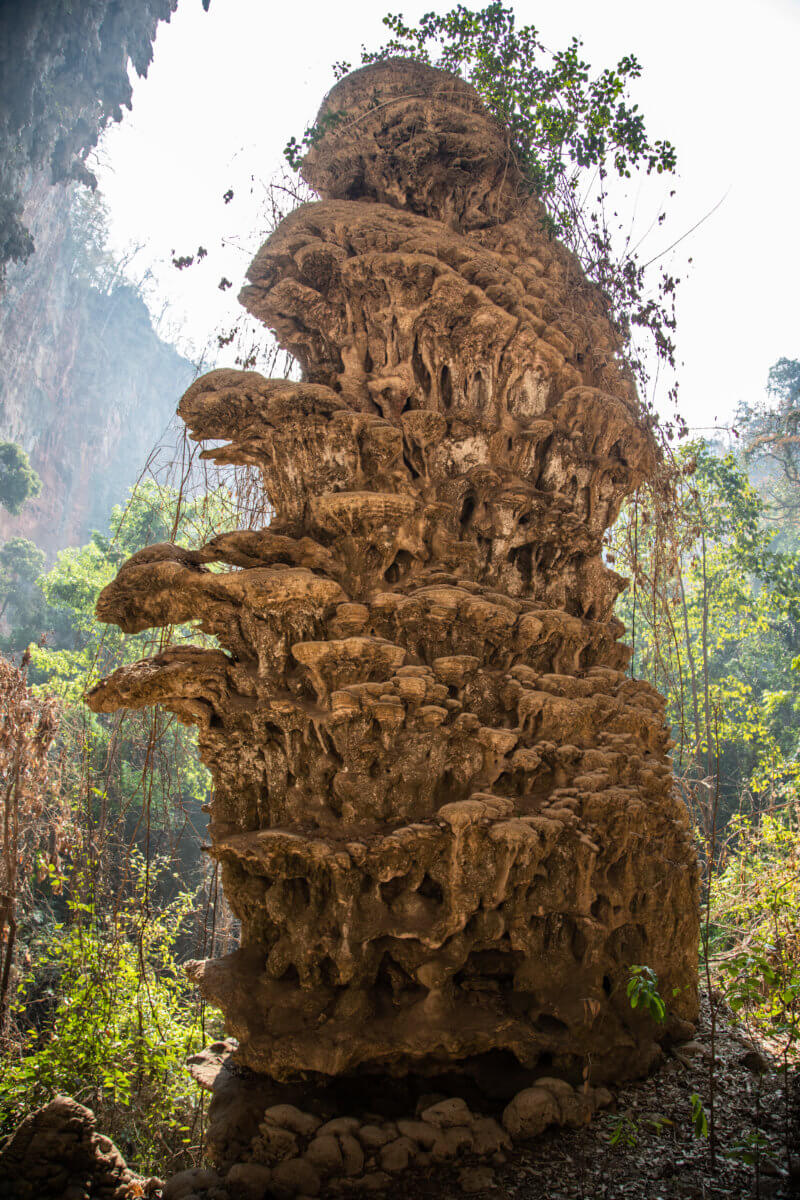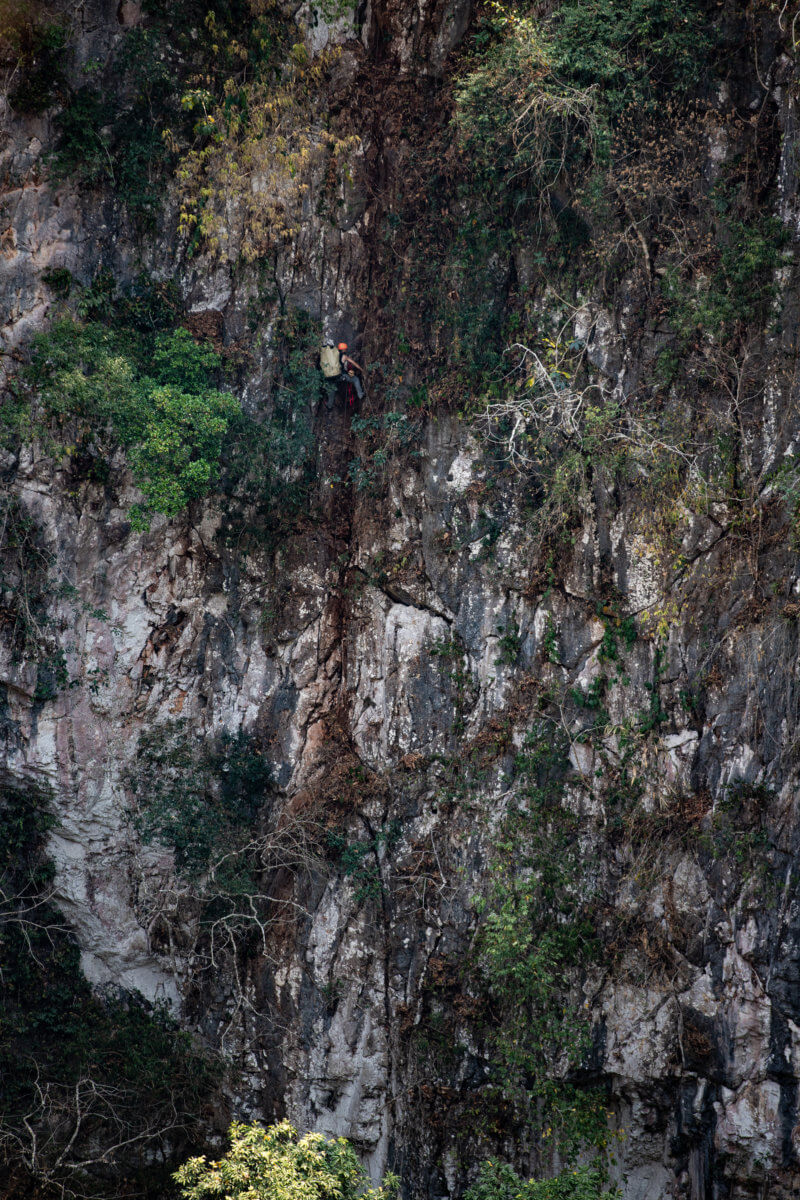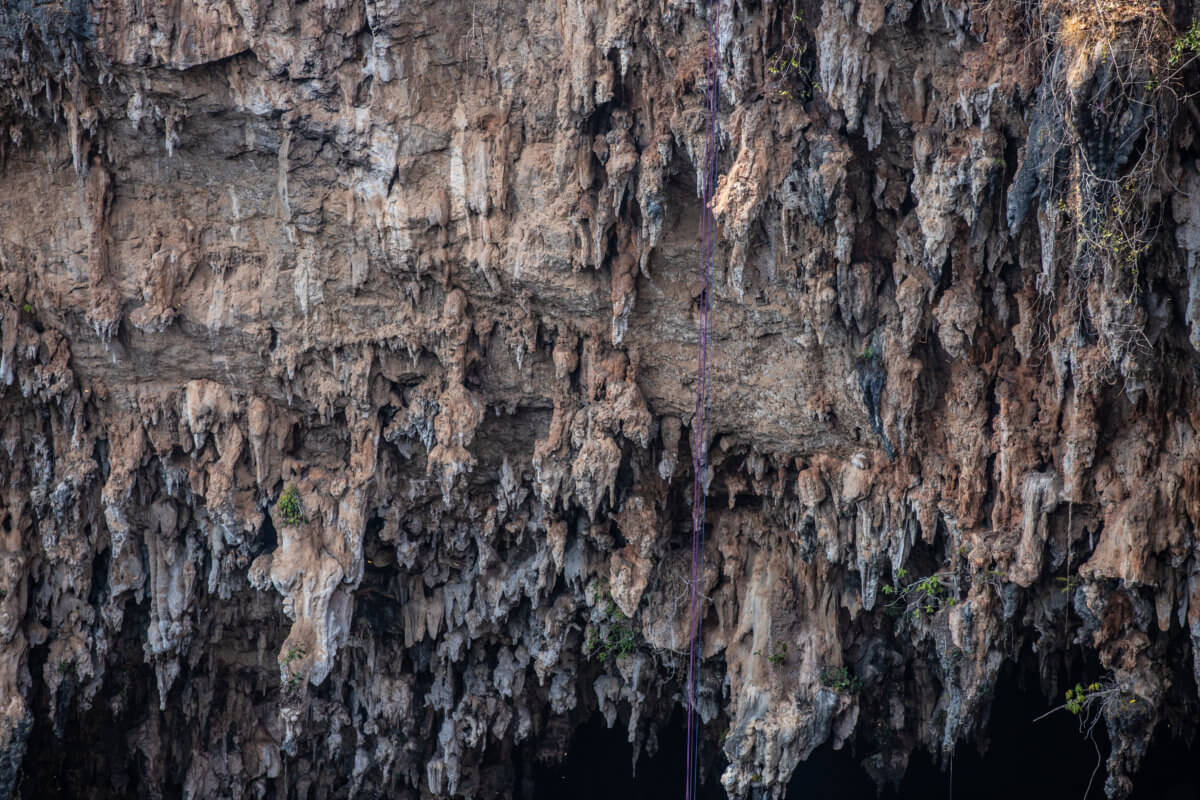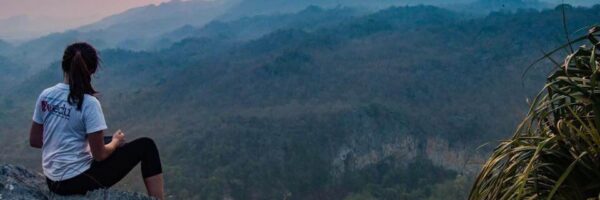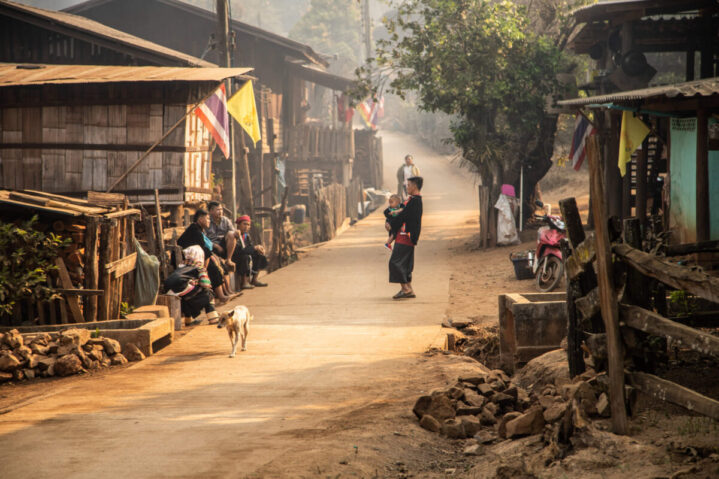
Descent into Nam Baw Pi
It took me three trips to Mae Hong Son to get to the bottom of the sinkhole. The first trip was just reconnaissance. I bought 120m of brand new rope on the second trip, but after throwing it in, very quickly realised that we needed more rope to reach the bottom. You don’t plan an open air rappel into a 200m deep sinkhole in an afternoon. You need to do some prep work, and you need a good partner.
I met Kelsey while climbing at Nam Pha Pa Yai, one of Thailand’s hidden gems. He has bolted hundreds of his own routes all over the world. I thought this seems like the right kind of guy. I asked him, “Hey Kelsey, do you want to rappel 200m down, all hanging in the open air, into a sinkhole that has no other access, camp at the bottom, and try to climb out of it the next day?” Of course, he was. This guy was born for adventure. That’s what I love about Thailand; it attracts the right type of people. He even had the rope!
Right: The author ascending the cliff wall to exit the sinkhole
Photos by Kelsey Gray
At one point while packing for the trip, Kelsey said offhandedly, “We should probably bring a knife, just in case…” So we loaded up Kelsey’s haul bag with 400m of rope (and one knife) and set off towards Mae Hong Son. When we arrived at Ban Luk Khao Lam we sought out the village head immediately. In nine years in Thailand I have never actually needed my Thai. I needed it that day.
We were shuffled around a few times before finally finding the village head and learned that we actually needed to talk to the forestry service, who had an office back in Bang Ma Pha, a town about 40 minutes away. Amazingly, we managed to get the permits inside an hour. We snapped photos, joked around, and we were good to visit, and good to descend, and good to climb out. We even had time to set up ropes on the hotel’s rafters and practice passing a knot on rappel, which we had have to do the next day. Thank God for that.
Right: The roof of the collapsed cave had hundreds of giant limestone tufa formations
Photos by Kelsey Gray
We woke up early and convinced one of the villagers to let us rent two of their motorbikes to get up the steep hill, and I do mean steep. This thing was a struggle on the way up, but it was pure terror on the way down, especially with 40kg of gear on your back. Somehow, we made it to the top of the mountain and pulled out the machete to find the descent point. It took a lot of bushwhacking, but we found the right spot and, we think, the same four trees that I used to anchor the ropes on the first attempt. It took 60m of rope and about 3 hours just to make the anchor, but we felt confident about it when it was all said and done. We had to be after all, lives depending on them and all that.
I went first and Kelsey went around to take photos. The initial part of the descent went smoothly, though my heart was beating out of my chest when I first went over the edge. The giant tufa’s had not changed since my first visit, and they had not become any less impressive. The sinkhole formed when a cave collapsed onto its largest chamber, which would have been around 200m high at that point. At one point the cave had access through the mountain and prehistoric civilisations used it. The first descentionists found artefacts in the 100m cavern beyond the arch that formed after the collapse. Our descent point was at the highest part of the arch, straight down in front of the large cavern. As I dangled in space I couldn’t see the end of my two ropes, but I could admire the huge limestone formations which looked both close enough to touch and yet as far away as the opposite wall of the sinkhole, some 150m across. The sinkhole itself was nearly completely round, though the depth varied from about 150m at our point to 100m on the opposite wall. Every wall was a sheer drop, except for the roof of the cave I was hanging in front of.
The formations beneath had formed underground for tens of thousands of years from the rainwater seeping through the cracks in the mountain, forming shapes that boggled the mind, and were larger than any individual rock formations I had seen before. Inside nested sparrows which flew in huge flocks near dusk, swooping and turning above trees that reached 50m high and shot straight up as arrows, but were still dizzyingly far below.
I inched down the rope and the ground did not seem to grow larger for quite a while. The two ropes I was on were actually made of three, with one that was 200m and reached from the top straight to the bottom uninterrupted, and the second made up of a 100m and 60m rope tied together. When I reached the knot, I was only just above the trees and finally realised just how massive they were.
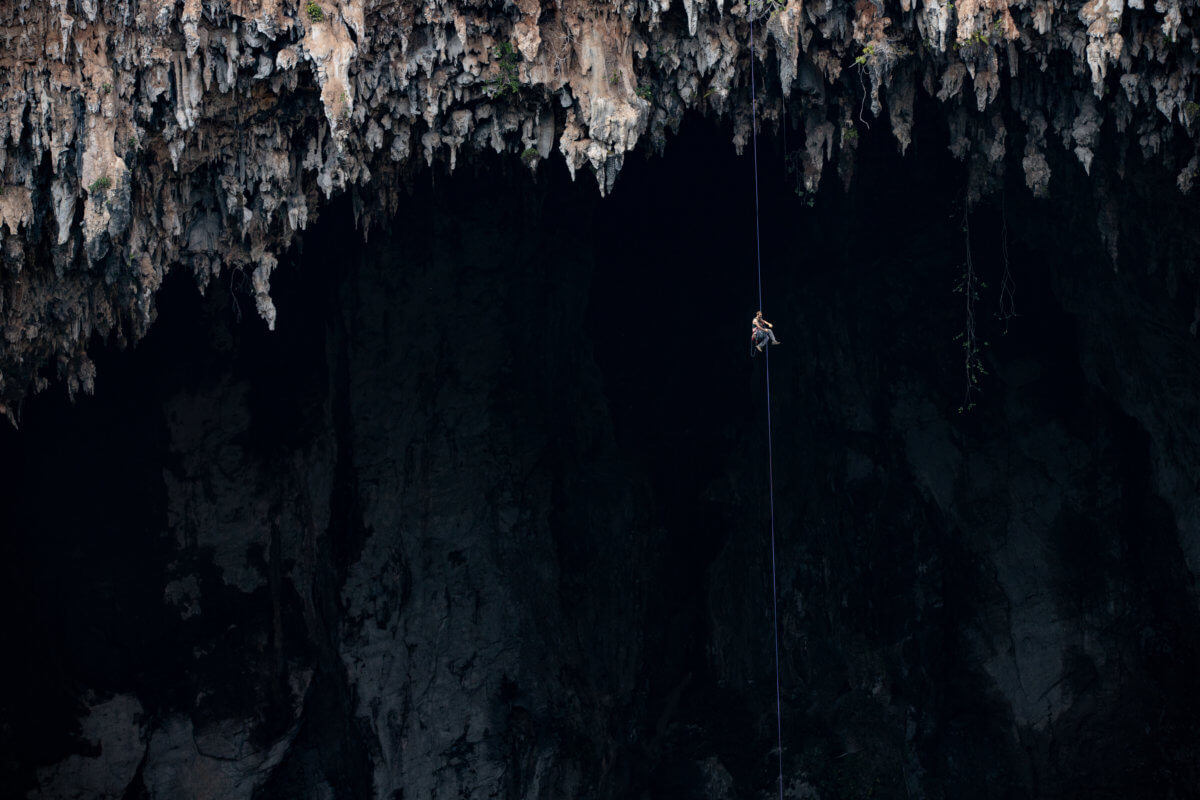
Photo by Kelsey Gray
This is when it got interesting. The condensed process of how to pass a knot on one of your ropes involves securing your harness above the rappel device with a small cord called a prusik, taking then your weight off the rappel device, move the device below the knot, re weight the device, and take the prusik cord off from above. The carabiner connecting my prusik cord to the rope above the knot jammed during this process, meaning I could not move up or down. It was in this moment that Kelsey called me on the radio:
“Hey uh… Nick… there are some guys up here, and they seem pretty upset. Uhhh (nervous laugh) they have guns, haha.”
“What?? I’m stuck. My carabiner’s jammed.”
“Oh, that’s not good. But yeah… I think they’re asking about the permits… “
“Shit. We don’t have the actual permits, they just sent us photos… they’re on my phone.”
“Well uh… maybe you should talk to them?”
“Ok, ok, put them on.”
Luckily, though I didn’t realise it at the time, I had left my phone in a bag at the top of another vantage point. Apparently these were soldiers and I’m still not exactly sure why they were patrolling the area, but dangling on that rope above the treetops that didn’t really matter. I explained that we had the permits, saying everything was fine. Then they explained to me that everything was not fine, that I needed to show them the permits, and that I needed to get out of the sinkhole right that second. They weren’t very sympathetic to the fact that I had gotten myself stuck, either. It was a stressful time, but once Kelsey tracked down my phone and found the photos, the patrol became a lot nicer and even hung out for a few minutes to watch as I continued to struggle with my knot in vain.
Luckily, after Kelsey’s offhand comment, I had my knife on my harness. I cut the prusik cord that secured me above the knot and continued my descent with that damn carabiner still stuck to my leg loop. I couldn’t get it off until I got back to Bangkok and sat down with two pairs of pliers to unscrew the locking sleeve. Finally, after about an hour since starting, I reached the bottom and radioed to Kelsey. His descent went smoothly, and I explored the huge space beneath while waiting for him to make his way down.
The plant life down there was incredible. Truly Jurassic. There were ferns the size of living rooms and vine systems covering areas the size of football fields. A huge chunk of the roof had collapsed and formed a small canyon with walls 20m high on each side. A 20m tall stalagmite under the main arch looked like something out of Alice and Wonderland with its otherworldly platforms, mushrooms and pedestals. The dirt was loose and the ground steep, but in the centre was a more or less flat area where we ended up setting up the tent for the night and trying to start a fire. Never have two men tried so hard and accomplished so little as the two of us tried to start a fire by hand.
The next day we hiked to our ropes hanging down, rigged ourselves up, and began the long, hard task of climbing out. When we reached the top, we were exhausted, and after the harrowing trip down we finally made our way back to Pai and enjoyed the greatest bowl of Khao Soi I have ever had in my life, checked the news, and found that during our night in the cave with thousands of bats, the last three days saw an explosion of virus cases and the Covid pandemic began.
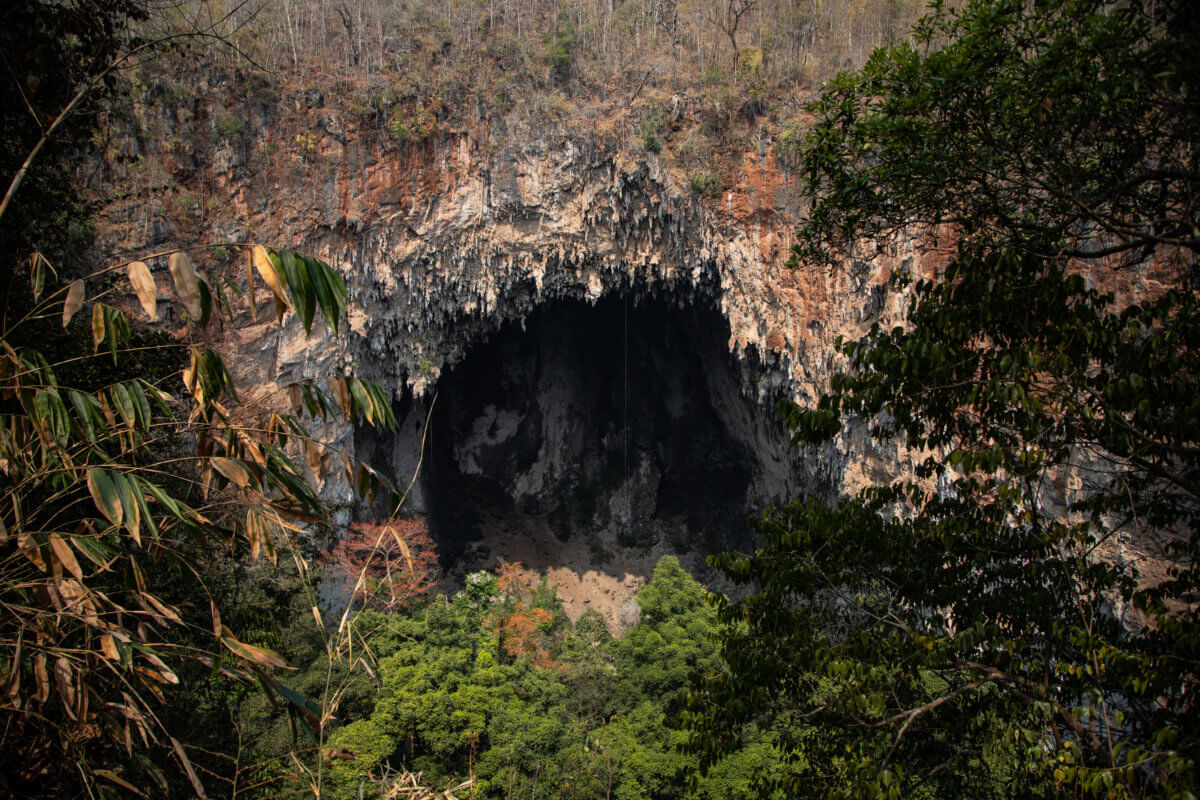
Photo by Kelsey Gray
Contact information
If you would like to attempt the rappel into the sinkhole, please hire a professional guide. It is an extremely dangerous activity and should not be undertaken by anyone without extensive climbing or caving experience. When speaking with the villagers I was told that only one or two trips are organised per year, and they did not know the name of the company.
If you would only like to visit the viewpoint at the sinkhole, please still remember to stop by the forest service office in Pai. I do not have the location as we went to a different office in Bang Ma Pha, but were told that they were only making an exception for our case.
If you have any other questions about the sinkhole, you are welcome to contact me directly at the email address listed below.
Nick Bernhardt is an American who has been living in Thailand for 9 years. He owns a consultancy firm that performs market research and due diligence work and enjoys climbing, motorcycles, and exploring Thailand’s paths less travelled. He can be reached at [email protected].


